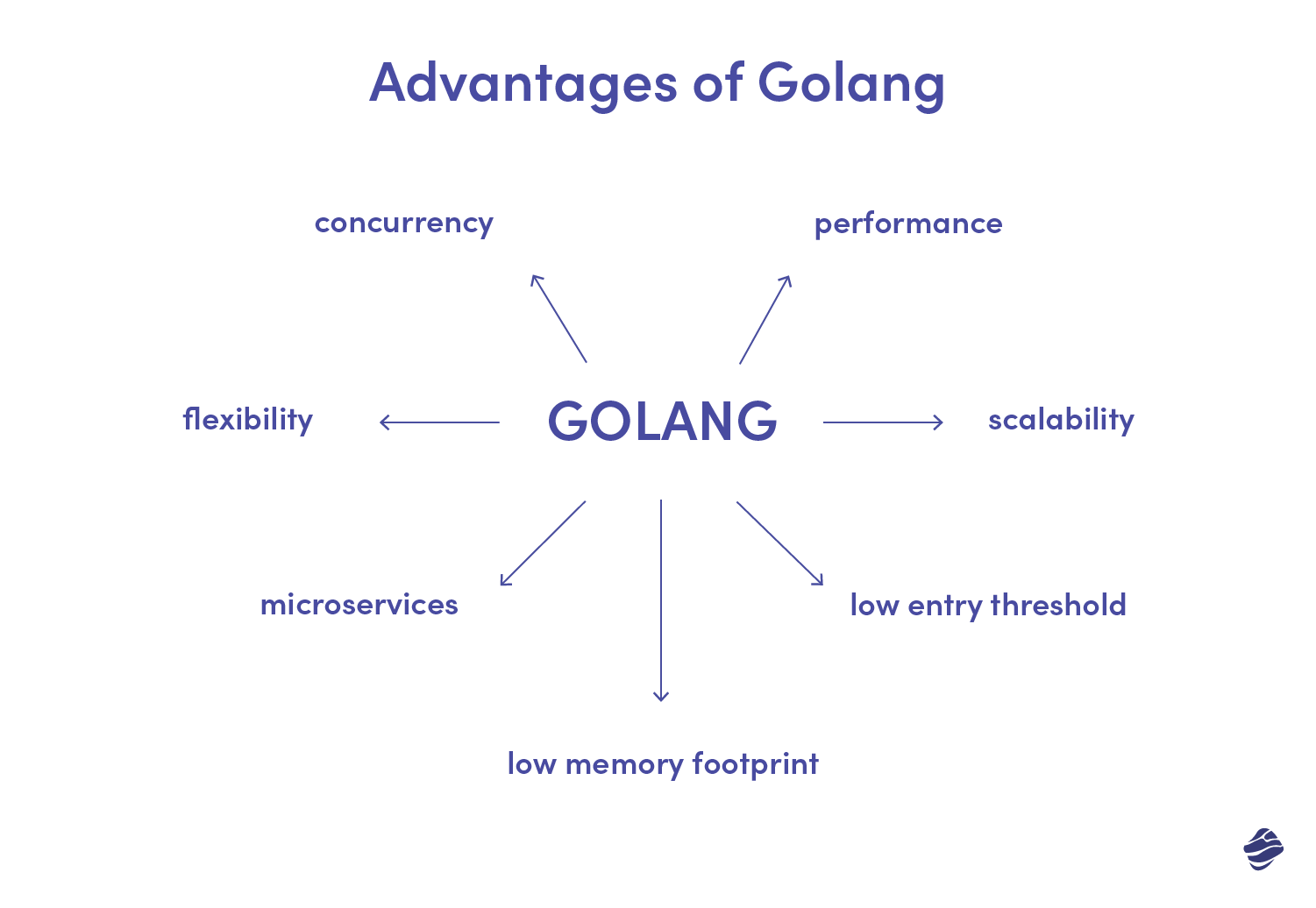Nowadays, Go programming language is quite popular among developers, but if you’re not an IT specialist you may not know it. So, what is the hype all about?
Also known as Go, Golang is an open-source, modern programming language released in 2009, and it’s been evolving rapidly since then. If it had just one selling point, it’d be this: Golang was developed by Google when its programming team realized neither Java nor C++ could meet their specific requirements. Does this mean Go offers the best of both worlds? Let’s find out!
What is Golang used for?
The main strengths of Go are simplicity, strong typing and fast compilation times. It is attractive to programmers for sure, as it is easy to use. But why should you choose Golang for your next application? It’s time you get some answers!
Google developers created Golang specifically to build their backend applications. It makes it an obvious choice for developing any application which requires high performance and easy-to-understand, efficient code.
In short, there are a lot of projects that could be done with Go. And now, let’s have a closer look at everything it has to offer.
Golang for web and mobile app development
Golang has a powerful standard library and is a great programming language if you wish to develop a web or mobile application for your business.
One of the many reasons for you to choose Go is that it’s perfect for creating microservices architecture. Don’t worry, more info on that is coming in a second!
When it comes to web development, Golang’s built-in HTTP server and robust networking capabilities make it exceptional for backend services. The standard library includes everything needed to build production-ready web servers without relying on third-party frameworks. This results in cleaner codebases that are easier to maintain and debug.
For mobile applications, while Go isn’t typically used for the frontend UI components, it excels as the backend service powering mobile apps. Companies like Uber have utilized Go for their backend services that handle millions of requests from mobile clients. The language’s performance characteristics make it ideal for handling the high-concurrency demands of modern mobile applications.
Go’s compilation to a single binary also simplifies deployment across different environments, making it easier to maintain consistency between development, testing, and production. This is especially valuable in CI/CD pipelines where predictable builds are essential.
Golang for microservices and enterprise apps
Both mobile and web apps need to provide an outstanding user experience to succeed. Client expectations are growing rapidly as the technology develops and it is difficult to please them.
Microservices infrastructure is an alternative approach for building large web and mobile applications. This approach suggests dividing complex apps into many smaller solutions, each of which can function with a certain level of autonomy. In such a way, the final version of the app has improved performance, is more secure, and requires lower maintenance efforts.
Golang’s architecture consists of independent components, meaning that each can be written with different technology. This allows you to answer the various needs of your clients within one app at the same time.
Moreover, it makes the Go microservices infrastructure a fully scalable solution which prevents the whole app from crashing. Even if one of the components requires developer attention, the rest can still remain mostly unaffected and functional.
Golang for cloud applications
If you want to deploy your application in the Cloud, you need a technology that will easily deal with concurrency problems. Simply put, concurrency allows programmers to break the program into semi-independent components that speed up the working process and protect the code from malfunction.
The essence of cloud-based solutions is scalability and ability to share resources. They allow you to access and update both data and documents with no obstacles. For that, it is important that the technology is capable of passing and storing large amounts of data simultaneously and that a failure in one sector doesn’t block the entire process. That’s exactly why, thanks to its built-in concurrency, Go is a perfect programming language for developing scalable Cloud applications.
Since 2023, Golang has become even more dominant in the cloud-native space, with many Kubernetes components and cloud infrastructure tools now written in Go. The language’s efficiency and small binary size make it ideal for containerized environments, where resource optimization is critical. Docker, Kubernetes, Prometheus, and etcd are all built with Go, cementing its position as the language of choice for modern cloud infrastructure.
On top of that, Go language is known for its high portability and networking features that allow you to leverage all the advantages of cloud computing. Many companies opt in for rewriting their old software with Golang to improve the overall performance, scalability and safety of their systems.
Well-known cloud brands, such as Dropbox, use Golang for their services. We’re not saying this alone is a good reason to jump on a bandwagon, but as a rule, when global giants get behind a certain technology, you can expect better and more timely support, updates, and maintenance. So you can be sure that relying on Go for cloud-based solutions’ development is fool-proof.
Is Golang good for AI development?
Go is increasingly being adopted in the AI and ML space. While Python still dominates data science, Golang is making significant inroads, particularly for deploying and serving ML models at scale.
AI can support your company in many ways. Artificial Intelligence grants you automatization and optimization that allow you to save a lot of time and money on routine processes. Cognitive technologies can help you make faster and better business decisions. You can minimize the risk of making mistakes. Customer service and sales can also be improved using AI. The possibilities are endless.
Golang vs Python for AI
Before Go language, Python was widely used for artificial intelligence. Now we know that Go is better for writing server-side scripts. Once again, Golang’s concurrency sets it apart. In particular, when it comes to machine learning.
In order to manage and deploy ML models, various services have to run simultaneously and fast. Enter GoRoutines – built-in timers and channels that allow them to schedule and, hence, accelerate the processes. Python lacks such an optimization.
Similarly, Go is a better choice than Python if you want your command line tools to run on Mac or Linux. Unlike Python, Golang ensures that CLI will work in different environments with minimal dependencies, making distribution easier.
We highly recommend this technology and will be happy to develop revenue-driving AI-based solutions for your business with Go. You don’t have to worry about a thing – our Golang developers have used it in many projects, so we are experienced in it and can guarantee the best results!
10 Key benefits of using Golang in 2025
As you can see, Go has various applications and can be used for almost any project that requires high performance. But it actually goes beyond that.

Here are some more advantages of using Golang for your next project:
Lightweight binary files for smaller applications
The binary files in Golang allow for producing applications that weigh less, regardless of the number of features and their complexity. This leads to faster downloads, reduced storage requirements, and improved deployment efficiency.
Performance boost in recent Go versions
Recent benchmarks in 2024 have shown that Go 1.22 and 1.23 have brought substantial performance improvements, particularly in garbage collection and concurrent operations, making it faster for certain workloads than previous versions.These improvements translate directly to cost savings and better user experiences.
Seamless scalability
Applications built with Go can be scaled or transformed fast and without any problems. Because of its high app scalability, Golang is the best choice for small and medium businesses that want their apps to grow together with the company. As for larger enterprises, Go helps dealing with higher volumes of traffic while maintaining consistent performance.
Cross-platform support
Applications developed in Go can be used with many operating systems and platforms. Go’s WebAssembly support has also improved significantly, making it viable for frontend development alongside its traditional backend strengths. This cross-platform capability reduces development time and maintenance costs.
Superior speed through efficient memory management
This open-source programming language is suitable for projects that require high performance, because it has built-in features that allow for the reduction of memory usage, such as garbage collection. The result is applications that respond faster and handle more concurrent users with the same hardware.
Modern language features for contemporary hardware
Go is a young and modern language well-suited to contemporary hardware requirements. The language continues to evolve, with Go 1.23 introducing significant improvements to its type system and generics implementation. These ongoing enhancements ensure your codebase remains efficient and supported.
Simple syntax for fast team onboarding
Your in-house IT specialists will have no problem taking over the application once the development is over thanks to its simple and readable code. The learning curve for Golang is remarkably short compared to other languages, reducing onboarding time and increasing team productivity.
Faster time-to-market for applications
Thanks to all its benefits, you will have no problem releasing your Go-based application. But if you still have any doubts our team will take over the implementation and make things even easier for you. Golang’s compilation speed and deployment simplicity mean faster time-to-market for your projects.
Modern solutions for your business created with Golang will improve efficiency, reduce costs, and increase your profits. But don’t take our word for it! See for yourself which globally-known companies use Go.
Real-world Golang project examples
As a development company, we have also produced scalable and efficient apps for many companies using Go. You can see all of our work in our Portfolio, but here are some of the most note-worthy Golang-specific projects:
HelloFresh
HelloFresh lets you order chef-crafted meals based on your individual requirements straight to your door. Every nutrition programme is based on a dietician’s recipe, ensuring the products meet specific health requirements. Our key goal was to make the application intuitive and simple. Golang has simplified many backend processes, making the project completion faster and easier to maintain for the development team.
Hub4Kids
Our team developed a custom web application simplifying the volunteer registration for Hearty Foundation, which fights social inequalities. Built on React and Golang, Hub4Kids became an effective pro-bono solution that lets users focus on the cause, instead of figuring out the technicalities.
Brainly
Need some help with solving a difficult problem for your next class? Brainly is an educational web platform that connects students and experts. Our developers built a Brainly Content Tool for managing the answer requests on Brainly.
But enough with the bragging, let’s talk about what’s really important here. What’s in all of this big Golang talk for you?
Should your company use Golang?
Choosing the right technological services for each project is a highly individual process. Our consultants and developers usually start with learning your needs and requirements for the app you are interested in. We take into consideration factors such as the overall complexity of the idea, your budget, target market, etc. Golang is perfect for creating lightweight, scalable applications and implementing advanced modern technologies. It will be an equally great choice for startups focused on dynamic growth as it is for mature, big companies.
In 2025, Go’s combination of performance, simplicity, and growing ecosystem makes it particularly valuable for:
- High-performance microservices
- Cloud-native applications
- DevOps and infrastructure tools
- Real-time systems with high concurrency needs
- API services that require both speed and scalability
If you have some more questions or if you are unsure whether Golang will be the perfect language for backend engineering – just reach out to us! We’ll be sure to come up with the best solution for you together. And the rest will go down in history!







